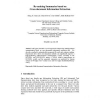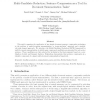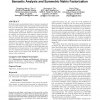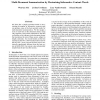COLING
2010
14 years 2 months ago
2010
Multi-document summarization aims to distill the most important information from a set of documents to generate a compressed summary. Given a sentence graph generated from a set o...
AIRS
2010
Springer
14 years 4 months ago
2010
Springer
This paper describes a novel approach of improving multi-document summarization based on cross-document information extraction (IE). We describe a method to automatically incorpora...
CIKM
2010
Springer
14 years 5 months ago
2010
Springer
Update summarization aims to create a summary over a topic-related multi-document dataset based on the assumption that the user has already read a set of earlier documents of the ...
SIGIR
2010
ACM
14 years 5 months ago
2010
ACM
In this paper we investigate a novel and important problem in multi-document summarization, i.e., how to extract an easy-tounderstand English summary for non-native readers. Exist...
IPM
2007
14 years 7 months ago
2007
In recent years, there has been increased interest in topic-focused multi-document summarization. In this task, automatic summaries are produced in response to a specific informat...
IPM
2007
14 years 7 months ago
2007
This article examines the application of two single-document sentence compression techniques to the problem of multi-document summarization—a “parse-and-trim” approach and a...
SIGIR
2008
ACM
2008
ACM
Multi-document summarization via sentence-level semantic analysis and symmetric matrix factorization
14 years 7 months ago
Multi-document summarization aims to create a compressed summary while retaining the main characteristics of the original set of documents. Many approaches use statistics and mach...
SIGIR
2008
ACM
14 years 7 months ago
2008
ACM
Extraction based Multi-Document Summarization Algorithms consist of choosing sentences from the documents using some weighting mechanism and combining them into a summary. In this...
IJCAI
2007
14 years 8 months ago
2007
We show that a simple procedure based on maximizing the number of informative content-words can produce some of the best reported results for multi-document summarization. We fir...
ACL
2007
14 years 8 months ago
2007
The increasing complexity of summarization systems makes it difficult to analyze exactly which modules make a difference in performance. We carried out a principled comparison be...







